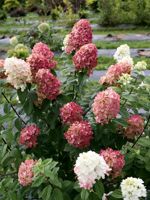Mon-Fri 9am - 5pm Mountain time
Black Elderberry vs Fire Light Hydrangea
Hydrangea paniculata Fire Light
Sambucus canadensis
CUSTOM GROW
NOT AVAILABLE THIS SEASON - MIGHT RETURN
Fire Light Hydrangea is a flowering shrub that is known for its striking colours. As they mature, the flower colour changes from a creamy white to a vivid deep pink. Hydrangea flowers persist longer compared to other flowering shrubs, blooming from late July into fall. They are a popular choice for flower arrangements.
The Fire Light Hydrangea can be grown as a stand alone shrub, as a hedge, or incorporated into a flower garden. Blooms occur on new wood, so regular pruning is encouraged in late winter. This is from the Proven Winners® collection.
Black Elderberry is a deciduous shrub native to eastern North America. You can plant this shrub in moist areas and it will help stabilize your soil. You can also use it on rural properties anywhere you'd use a lilac.
Black Elderberries are considered to be partially self-pollinating. So while they will still produce some berries without cross-pollination, planting with another variety will increase yields. Consider planting with Ranch Elderberry or Bob Gordon Elderberry.
Warning: the seeds, stems, leaves, roots, and uncooked berries of the Black Elderberry are poisonous to humans when eaten in quantity. You should cook the berries to make them safe for human consumption.
Fire Light Hydrangea Quick Facts
Black Elderberry Quick Facts
Toxicity: toxic to dogs, cats, and horses
Toxicity: leaves, stems, and uncooked berries are poisonous to humans

